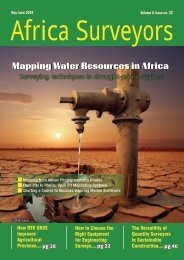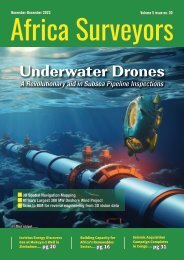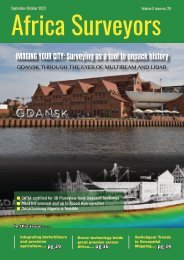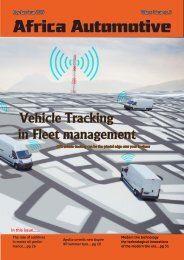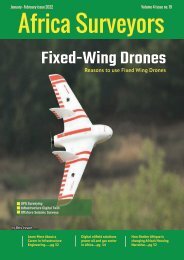Africa Surveyors May-June issue 2023 digital
Africa Surveyors is Africa’s premier source of Surveying, Mapping and Geospatial news and an envoy of surveying products/service for the Construction, Maritime, Onshore & Offshore energy and exploration, Engineering, Oil and Gas, Agricultural and Mining sectors on new solution based trends and technology for the African market.
Africa Surveyors is Africa’s premier source of Surveying, Mapping and Geospatial news and an envoy of surveying products/service for the Construction, Maritime, Onshore & Offshore energy and exploration, Engineering, Oil and Gas, Agricultural and Mining sectors on new solution based trends and technology for the African market.
Create successful ePaper yourself
Turn your PDF publications into a flip-book with our unique Google optimized e-Paper software.
UXO SURVEYING<br />
“Modern weapons are estimated to have a failure rate of 5%.<br />
Depending on various factors, the failure rate can be up to 40%. Any<br />
armed conflict in the world has created, creates, and will create the<br />
same problem,” perceive Alexey Dobrovolskiy, Chief Technology Officer<br />
at SPH Engineering.<br />
Although UXO threat is increasing globally, however, survey<br />
technologies and clearance methodologies are also improving in line<br />
with this threat, allowing for faster, more accurate target identification,<br />
environmentally conscientious clearance and the reduction of overall<br />
risk to land-based and water-based site projects. Detecting land or<br />
underwater UXO is complex and can require well designed surveys<br />
with high sensitivity sensors.<br />
"Unexploded ordnance pose significant risks to both human lives and<br />
infrastructure development. Ground penetrating radar (GPR) can be<br />
an effective tool for locating land-based UXO. GPR can detect objects<br />
at various depths, ranging from a few centimeters to several meters,<br />
depending on the specific equipment and soil conditions. GPR enables<br />
survey teams to detect subsurface anomalies, such as munitions or<br />
buried objects, in real-time without the need for excavation, enabling<br />
faster and informed decision-making,” comments Allison Annan-Bujold,<br />
GPR Product Management Director at Sensors & Software Inc.<br />
Managing the process of UXO surveys is important and often involves<br />
multiple stakeholders. It can be a costly and time-consuming task.<br />
This is where a good workflow and commonly agreed data quality<br />
factors are important. This can make it easier for project stakeholders<br />
to understand how a survey will be conducted, and what data quality<br />
thresholds are expected from the sensors used in order to detect a<br />
given reference object. It also allows the team to spend more time on<br />
data analysis, interpretation and reporting.<br />
With reference to Stephen Wilson, Director of Business Development<br />
& UXO Manager at EPI Group, “We always start with a UXO Threat<br />
& Hazard Assessment. Covering the project site boundaries and<br />
surrounding areas of influence, this is a desk-based study of the<br />
UXO history in the area, describing the types, possible condition, and<br />
density of UXO that may be present within an area of investigation,<br />
where, and why. These potential UXO hazards are then risk assessed<br />
against the planned project operations for their likelihood to cause<br />
harm to people, plant, environment and species of concern. Only those<br />
potential UXO that pose a risk need to be the subject of a UXO survey,<br />
if there are no risks identified, no survey is required. This ensures the<br />
UXO survey is specific to managing the actual project risks and that<br />
the “As Low As Reasonably Practicable” safety methodology, is a viable<br />
cost-effective solution that can be reached by all project developers.”<br />
As multi-sensor datasets become increasingly large, a well-defined<br />
workflow with commonly agreed data quality factors is essential to<br />
improve the transparency of both land or water-based UXO surveys<br />
and trust in their results. This will help to avoid miscommunications<br />
between survey teams, clients and project managers that could lead to<br />
expensive delays or even cancellation of a project.<br />
“GPR systems can collect data over a large land area and map the<br />
results," says Allison. "The software enables detailed data visualization,<br />
interpretation, and integration with geospatial information systems<br />
(GIS), aiding in the creation of UXO hazard maps that accurately<br />
represent the land locations, depths, and sizes of potential UXO<br />
targets. The mapping capability enables UXO detection teams to<br />
prioritize and plan their clearance operations," she adds.<br />
Importance of UXO Surveys<br />
UXO is a major concern for a wide range of projects, from construction<br />
and excavation to wind farm installations, oil exploration, offshore<br />
oil & gas platforms and capital dredging. As a result, it is necessary<br />
to plan and execute the survey to ensure that any potential hazards<br />
are identified prior to any land or sea activities. Detection is the most<br />
important aspect of any UXO survey. The aim is to locate, identify and<br />
then remove any items that are a threat to any property or people<br />
within an area. To achieve this, an expert survey team will need to<br />
understand the local environment and the likely threats. This will<br />
enable them to recommend the best possible detection method for<br />
the site.<br />
“UXO surveys are a key part of the management of UXO contamination,<br />
management meaning normally to remove the contamination for land<br />
release. There are different types of UXO surveys, and the process<br />
would depend on the specific situation at different geographic<br />
levels. Arguably the most important UXO survey is the Non-Technical<br />
Survey (NTS) or desk top survey, normally conducted prior to any<br />
planned encounter with UXO contamination, consisting of research<br />
and interviews. This would determine areas of priority, non or less<br />
contaminated areas, and the type of contamination, which in turn<br />
would determine the type of detection equipment needed for ‘on-site’<br />
survey to further confirm the findings of the NTS, and further clearance<br />
techniques and technologies required,” remarks Steve Marner, Senior<br />
Technical Delivery Manager at Artios Global Ltd.<br />
According to Wolfgang Suess, Managing Director at SENSYS, the<br />
importance of UXO surveys is manifold as buried UXOs in the ground<br />
that are leaking over time. “Chemicals are a threat to our environment<br />
and intact ammunition will lead to a lot of collateral damages and<br />
injuries or deaths. In order to release mined or contaminated areas<br />
to vitalize an economy especially in the areas of agriculture and<br />
civil engineering, UXO surveys have to be done addressing 100%<br />
of an area. For this kind of survey, an assigned expert will provide<br />
(aerial) remote operated or man operated detection systems with<br />
Magnetometers or electromagnetic sensors to detect all kind of bombs<br />
and ammunition in that particular land area. Additionally, metal and<br />
iron free plastic mines have to be detected by more specific devices<br />
or in labor intensive man based ground surveys – which by far are<br />
the most dangerous processes in demining,” expresses Wolfgang. “The<br />
problem of UXO is not only a problem on land, but in the water as well.<br />
Here again, leaking ammunition is harming our marine environment<br />
such that, TNT (Trinitrotoluene) and other elements are found in water,<br />
fishes and plants,” he adds.<br />
“There are four general methods for performing a sea based UXO<br />
survey. The two most common solutions are towed magnetometer/<br />
gradiometer or ROV based gradiometer. In certain scenarios and<br />
regions ROV based electromagnetic systems or 3D chirp systems<br />
could also be used, however, this is a more uncommon approach. The<br />
industry standard towed solution for large scale UXO campaigns today<br />
uses one or several remotely operated towed vehicles (ROTV), with an<br />
array of magnetometers or gradiometer,” acclaims Thomas Mennerdahl,<br />
Technology Director Subsea at Reach Subsea AS.<br />
www.africasurveyorsonline.com<br />
<strong>May</strong>-<strong>June</strong> <strong>issue</strong> l <strong>2023</strong> 13




